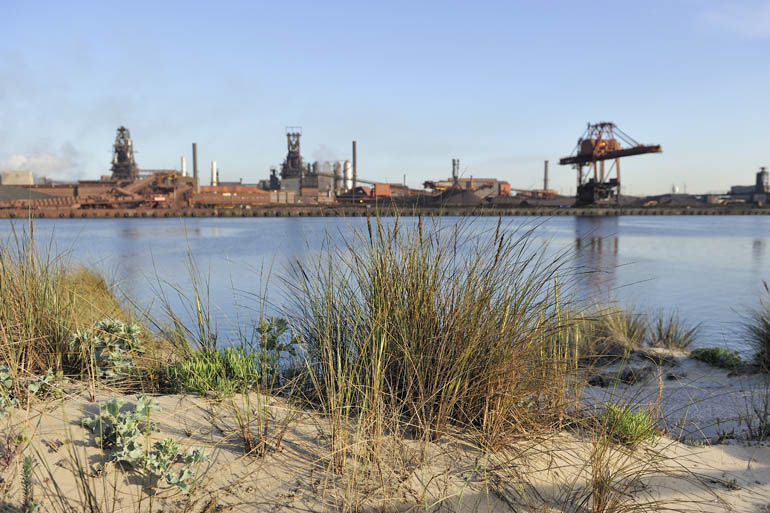The maritime economy encompasses numerous sectors of activity related to the sea: extraction of marine resources, public services, industries, operation of maritime sites, etc. The French maritime economic data published by Ifremer comprises a set of sector-based indicators designed to assess the economic importance of these activities, their role in the national economy, their place within international competition, as well as the importance of non-commercial public services.

©Ifremer
Different fields of activity
Within the maritime economy, there is a wide variety of fields of activity related to the sea:
- extraction of marine resources that constitute raw materials (living, mineral and energy resources)
- exploitation of maritime areas and physical properties of the seawater and seabed, which also constitute resources (renewable and nuclear energy, laying of undersea cables, construction of maritime and coastal infrastructures, maritime transport, navy).
- use of remarkable marine and coastal sites (tourism, leisure activities, pleasure boating)
- industries using and transforming biological resources (sea produce, seaweed)
- manufacturing sectors and upstream services for maritime industries: shipbuilding and repair, boat building, offshore energy services, financial services for transport and pleasure boating
- public services: defence, support for maritime activities and seafarers, protection of the marine and coastal environment, marine research and operational oceanography.
Scope of the maritime economy
The scope of the maritime economy however is open to debate and its limits often depend on the specificities of national economies. In the case of the French maritime economic data, this perimeter has shifted and now encompasses river transport. On the other hand, certain sectors raise statistical issues, for instance, the production of sea salt or maritime banking services.
In relation to the above-mentioned fields of activity, this scope therefore covers the following sectors:
Industrial sectors
- Sea produce: sea fishing, aquaculture, sea produce sales, seaweed production and processing, sea produce processing
- Extraction of marine materials
- Energy production: electrical power stations installed on the coastline, marine renewable energies
- Shipbuilding and repair: building of civil and military vessels, ship equipment, ship repair, boating building
- Public works related to the sea and rivers
- Manufacture, laying and maintenance of undersea cables
- Offshore oil and gas-related services
- Coastal tourism
- Maritime and river transport: maritime and river port services, maritime transport, river transport
- Maritime insurance.
Non-commercial public sector
- French Navy
- Public involvement in the maritime field: navigational aids, safety and security, seafarer training, social protection
- Protection of the coastal and marine environment
- Marine research

©Ifremer - Olivier Dugornay
Indicators and sources
The economic indicators used to monitor maritime activities are sector-based indicators such as turnover, added value, employment, number of companies and export rate. The public sector is described by budgets, numbers of employees and the costs of personnel attributed the different missions.
These indicators are provided by various sources:
- Sector-based indicators provided by the French National Institute of Statistics and Economic Studies, INSEE, based on the French classification of activities (NAF), which make up a foundation of essential statistical information for analysing industrial sectors. The NAF classification divides activities into sectors without any double counting, thanks to the Statistical classification of economic activities in the European Community (NACE) which allows international comparisons.
- Satellite accounts, such as for transport, tourism and the environment
- Data from professional associations and certain businesses (to assess certain sectors which are not identified in the classification of activities)
- Indicators provided Eurostat and professional associations for European comparisons
- Data obtained from specialised public sector services (in particular, the French Navy, the Directorate of Maritime Affairs and the Directorate of Transport Infrastructures) and scientific research organisations.
The challenges of French maritime economic data
All the data collected is presented in the form of short time series over recent years. However, the availability time periods for these statistics must be taken into account: a uniform update of all the maritime data will at best apply to the year n-2 when all the French maritime economic data are published at the end of year n.
Another major difficulty encountered in the evaluation of the maritime economy for a given country is that certain maritime sectors do not exist individually in national statistics. They are part of broader sectors (e.g. cable manufacture, oil-related services, tourism) for which only the maritime part must be evaluated. This therefore requires estimations to be made, which are, by their very nature, contestable, and we strive to improve their reliability through information obtained from businesses. The successive updates to French maritime economic data aim to improve the quality and traceability of the indicators.

©Ifremer
